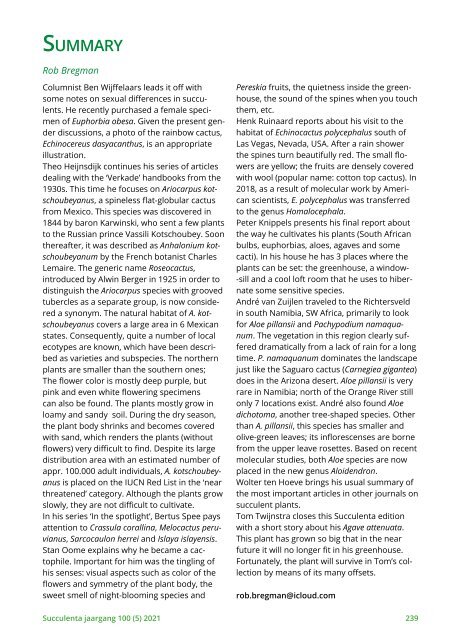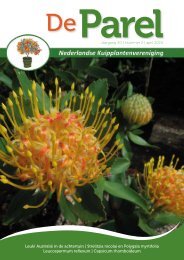You also want an ePaper? Increase the reach of your titles
YUMPU automatically turns print PDFs into web optimized ePapers that Google loves.
Summary<br />
Rob Bregman<br />
Columnist Ben Wijffelaars leads it off with<br />
some notes on sexual differences in succulents.<br />
He recently purchased a female specimen<br />
of Euphorbia obesa. Given the present gender<br />
discussions, a photo of the rainbow cactus,<br />
Echinocereus dasyacanthus, is an appropriate<br />
illustration.<br />
Theo Heijnsdijk continues his series of articles<br />
dealing with the ‘Verkade’ handbooks from the<br />
1930s. This time he focuses on Ariocarpus kotschoubeyanus,<br />
a spineless flat-globular cactus<br />
from Mexico. This species was discovered in<br />
1844 by baron Karwinski, who sent a few plants<br />
to the Russian prince Vassili Kotschoubey. Soon<br />
thereafter, it was described as Anhalonium kotschoubeyanum<br />
by the French botanist Charles<br />
Lemaire. The generic name Roseocactus,<br />
introduced by Alwin Berger in 1925 in order to<br />
distinguish the Ariocarpus species with grooved<br />
tubercles as a separate group, is now considered<br />
a synonym. The natural habitat of A. kotschoubeyanus<br />
covers a large area in 6 Mexican<br />
states. Consequently, quite a number of local<br />
ecotypes are known, which have been described<br />
as varieties and subspecies. The northern<br />
plants are smaller than the southern ones;<br />
The flower color is mostly deep purple, but<br />
pink and even white flowering specimens<br />
can also be found. The plants mostly grow in<br />
loamy and sandy soil. During the dry season,<br />
the plant body shrinks and becomes covered<br />
with sand, which renders the plants (without<br />
flowers) very difficult to find. Despite its large<br />
distribution area with an estimated number of<br />
appr. 100.000 adult individuals, A. kotschoubeyanus<br />
is placed on the IUCN Red List in the ‘near<br />
threatened’ category. Although the plants grow<br />
slowly, they are not difficult to cultivate.<br />
In his series ‘In the spotlight’, Bertus Spee pays<br />
attention to Crassula corallina, Melocactus peruvianus,<br />
Sarcocaulon herrei and Islaya islayensis.<br />
Stan Oome explains why he became a cactophile.<br />
Important for him was the tingling of<br />
his senses: visual aspects such as color of the<br />
flowers and symmetry of the plant body, the<br />
sweet smell of night-blooming species and<br />
<strong>Succulenta</strong> jaargang 100 (5) <strong>2021</strong><br />
Pereskia fruits, the quietness inside the greenhouse,<br />
the sound of the spines when you touch<br />
them, etc.<br />
Henk Ruinaard reports about his visit to the<br />
habitat of Echinocactus polycephalus south of<br />
Las Vegas, Nevada, USA. After a rain shower<br />
the spines turn beautifully red. The small flowers<br />
are yellow; the fruits are densely covered<br />
with wool (popular name: cotton top cactus). In<br />
2018, as a result of molecular work by American<br />
scientists, E. polycephalus was transferred<br />
to the genus Homalocephala.<br />
Peter Knippels presents his final report about<br />
the way he cultivates his plants (South African<br />
bulbs, euphorbias, aloes, agaves and some<br />
cacti). In his house he has 3 places where the<br />
plants can be set: the greenhouse, a window-<br />
-sill and a cool loft room that he uses to hibernate<br />
some sensitive species.<br />
André van Zuijlen traveled to the Richtersveld<br />
in south Namibia, SW Africa, primarily to look<br />
for Aloe pillansii and Pachypodium namaquanum.<br />
The vegetation in this region clearly suffered<br />
dramatically from a lack of rain for a long<br />
time. P. namaquanum dominates the landscape<br />
just like the Saguaro cactus (Carnegiea gigantea)<br />
does in the Arizona desert. Aloe pillansii is very<br />
rare in Namibia; north of the Orange River still<br />
only 7 locations exist. André also found Aloe<br />
dichotoma, another tree-shaped species. Other<br />
than A. pillansii, this species has smaller and<br />
olive-green leaves; its inflorescenses are borne<br />
from the upper leave rosettes. Based on recent<br />
molecular studies, both Aloe species are now<br />
placed in the new genus Aloidendron.<br />
Wolter ten Hoeve brings his usual summary of<br />
the most important articles in other journals on<br />
succulent plants.<br />
Tom Twijnstra closes this <strong>Succulenta</strong> edition<br />
with a short story about his Agave attenuata.<br />
This plant has grown so big that in the near<br />
future it will no longer fit in his greenhouse.<br />
Fortunately, the plant will survive in Tom’s collection<br />
by means of its many offsets.<br />
rob.bregman@icloud.com<br />
239

















